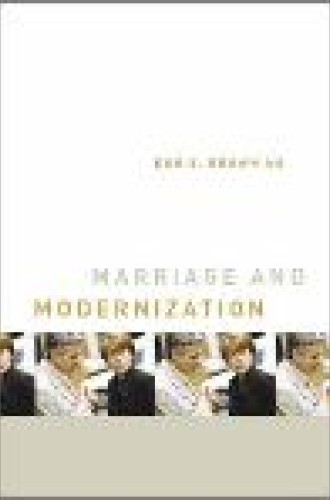Marriage and Modernization: How Globalization Threatens Marriage and What to Do About It
The phrase “family values” became an early catchword in the culture wars. The way people define those values and implement them politically marks a bitter line of division between liberals and conservatives. People on different points of the political (and religious) spectrum mean very different things when they talk about the role of marriage and family in society. Outside the U.S. and the Judeo-Christian tradition, the conversation becomes even more complex.
Don S. Browning’s thoughtful, provocative book seeks to cut through the jargon and polarization by arguing that “modernization” in its various forms has profoundly affected how we think about and practice marriage, and that religion has something crucial to contribute to how we understand and define marriage.
Marriage has always been influenced and often determined by larger social factors. In turn, the strength of marriage as a social institution reflects the health of a society. Changing attitudes toward gender and sexuality, the growing number of women in the work force, the stresses of occupational life, large-scale shifts in the economy, and the enormous challenges of raising children in a fast-paced, media-centered society in which values are in flux—all these have affected marriage.
But are the challenges Browning outlines any more daunting than those faced by people during the Industrial Revolution in Europe, the Cultural Revolution in China, or any period of major social change? The private-public nature of marriage, sexuality and gender roles means that seismic shifts on the sociopolitical front always have profound implications both for male-female relationships and the values taught to children.
In contemporary Western societies, changing sexual mores and gender understandings have been brought into the open and embraced as part of new understandings of relationship and of marriage. In the process, we have been losing our concept of marriage as rooted in Judeo-Christian thought and moral philosophy. Browning examines our attitudes toward the status of women, the role and responsibilities of men, and the contractual nature of marriage as a partnership “of equal regard,” tracing how these ideas have developed from early Christian times through the Reformation. Any attempts to “redefine” marriage must build upon these moral and cultural foundations. They are crucial to any understanding of commitment, legal or emotional. One of Browning’s central arguments is that in rendering such views of commitment irrelevant, modernization and its changes are pushing men to the periphery, detaching them from traditional, religiously grounded commitments.
What should religion do in response? One of Browning’s most intriguing suggestions is that all world religions can help address these questions. I wish his reflections along these lines had been more developed. He compares the U.S. to South Korea and concludes with a discussion of “world family strategies,” but the rest of the book is so focused upon Western, capitalist, predominantly Christian societies that he only opens the door to much broader questions. How, for example, would Muslim or Hindu thinkers in a religiously pluralistic society like India engage in a conversation with Indian Christians on these issues?
I also wish that Browning had discussed how the Christian response to the changing shape of marriage has been formed by the churches’ responsible and caring ministry to “unconventional” families, particularly around the issue of gay marriage. Browning, I suspect, would argue that such ministry needs to be theologically grounded. But theology emerges out of the church’s active ministry to the world, as well as out of responsible reflection on tradition and doctrine. For the gay Christian population, this ministry strengthens marriage as an institution of responsibility and commitment (not just rights) precisely because it is based upon a consciously embraced commitment that actually goes along very traditional lines.
The other major question is how religious points of view can realistically be brought into the public discourse on these issues. Here Browning calls for a kind of “discourse ethics”—an informed, “intersubjective dialogue” as a force to shape larger society—as well as a “practical theology of families.” One wishes that liberals and conservatives could at least start talking about the same things (and acknowledge that the high stakes in this matter—not least the future of our children—necessitate getting beyond the ideological barricades). But where would such a conversation take us, and how or where could it be turned into policy?
Such questions illustrate that this is a book that should be thought about and that one can argue with. As someone who comes from the liberal end of the theological spectrum, I think Browning is raising the questions that need to be addressed by all of us. I would agree that for too long liberal theology and its institutions have allowed this area to be defined by the conservatives. As a society, we really do need to talk about both the moral underpinnings and the moral consequences of family-related issues.
If conservatives are too proactive in their attempt to set the standards for the rest of us, liberals have been far too reactive—as though changes in how we define marriage and family and raise our children are no big deal and can simply be lived with. At the heart of Browning’s message is the conviction that such changes are profound and should not be allowed to happen thoughtlessly—that is, without reflection and, yes, debate about their moral and social consequences. Only such reflection and debate can give us the moral foundation for social and political policies that truly support all families.





